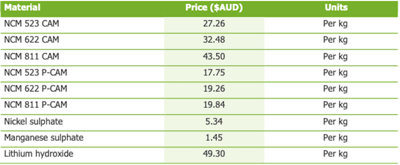How Australian Mines’ Sconi output could change the EV game

Pic: Matthias Kulka / The Image Bank via Getty Images
When Australian Mines took a look at the booming EV battery market it aims to supply, it saw a niche that most miners have yet to fully tap.
That niche was in combining commodities to suit the downstream production of battery materials – something a number of miners shied away from in favour of shipping off output for sale on the open market and subsequent processing abroad.
“The problem our sector has is that it likes commodity prices to be higher, because mining companies make more money when commodity prices are higher,” Australian Mines managing director Benjamin Bell told Stockhead recently.
“That’s fine. But when you look at the EV sector you’re feeding, which has become a goal for nations globally but at this stage is marginal without government incentives, the only way you can actually build an EV business is for cars to be cheaper.
“When a Tesla the size of a Corolla costs $100,000, it’s a hard pitch for the manufacturer to turn around and sell it to the consumer – increasing commodity prices are what our industry wants but they do the exact opposite of what our society needs when it comes to EV.”
It was here that Australian Mines (ASX:AUZ) saw an untapped opportunity to meet the market in the middle – taking a stance which it believes will increase profits, help lower the price of cars, and fully leverage the tier-one Sconi nickel-cobalt-manganese deposit in Queensland.
The idea is to produce battery precursor cathode active materials (P-CAM) at Sconi – a task the orebody is specifically placed to achieve.
Where a kilogram of nickel sulphate may sell for $5 per kilogram, a precursor – the next stage along in the downstream battery manufacture process – can sell for $20/kg.
The below chart tells the story best.

Sconi is the asset which creates the opportunity. The project, which has an ore reserve of 57.3 million tonnes, and a mineral makeup which aligns with the most common batteries in the world.
“Our orebody is effectively an NCM battery orebody,” Bell said.
“We have nickel, cobalt and manganese, and we have it in about the same concentrations as an eight-one-one battery – for every seven parts of nickel we have one part cobalt and one part manganese.
“We realised we had an NCM concentration in the ground from surface there, which we were then going to break up and sell into its various components. Breaking it up so someone else can put it back together again seemed like an unnecessary step.”
The result of this realisation was the research and development of P-CAM manufacture, a successful venture to date and one which has led to a scoping study on the economics of replacing the existing nickel and cobalt sulphate circuit in the Sconi production plant flowsheet with a P-CAM production facility.
That study, which complements the existing bankable feasibility study for Sconi, is ongoing.
In the meantime, AUZ is progressing its testing by purchasing lithium off the market and adding it to the P-CAMs samples it’s currently working on. By doing that, the company could add another substantial layer of value to its market offering.
Meeting in the middle
The Sconi P-CAM idea was inspired by conversations between the AUZ board and prospective offtakers – car and battery manufacturers who before now had potentially never dealt direct with miners.
“Car companies and battery companies have never had to have these conversations before, even with steel or aluminium, it comes from an intermediate company,” Bell said.
“With EV, we’ve started to see these companies being forced to come to the mine gate, just as we saw when Tesla struck a deal with a lithium miner. A lot of them are uncomfortable with it.
“The way we see you make them comfortable is to say ‘don’t come all the way to the mine gate. We’ll come to you, and we’ll meet you halfway around the battery stage’.
“In a partnership, you need to make sure the other party is as comfortable as possible.”
As for the moving nature of battery composition, Bell said the orebody, which also contains aluminium, could be adapted to varied ratios without infrastructure changes.
On the sector more broadly, AUZ believes EV is firmly here to stay.
“When Apple wants to start making a car – and they’re saying they want one by 2024 – you know you’re in a booming space,” Bell said.
This article was developed in collaboration with Australian Mines, a Stockhead advertiser at the time of publishing.
This article does not constitute financial product advice. You should consider obtaining independent advice before making any financial decisions.

UNLOCK INSIGHTS
Discover the untold stories of emerging ASX stocks.
Daily news and expert analysis, it's free to subscribe.
By proceeding, you confirm you understand that we handle personal information in accordance with our Privacy Policy.








